Ever throw a ball and lose track of your dog before it even lands? You’re not alone. Some dogs are so fast, it’s hard to believe they’re not part machine. While many breeds love to run, only a few are built for speed bursts that blur the line between chase and flight.
If you’ve got a pup who constantly outruns your expectations—or you’re searching for a breed that thrives on pure acceleration—it helps to know which dogs have true sprinting power.
Because not every fast dog is a sprinter. Some are endurance runners, others are agile turners. But the ones in this article? They’re sprinters, through and through.
At the end, we’ll introduce the top speed-demon breeds and explore what makes them the undisputed kings of the short run.
Fastest Sprinting Dog Breeds
1. Greyhound
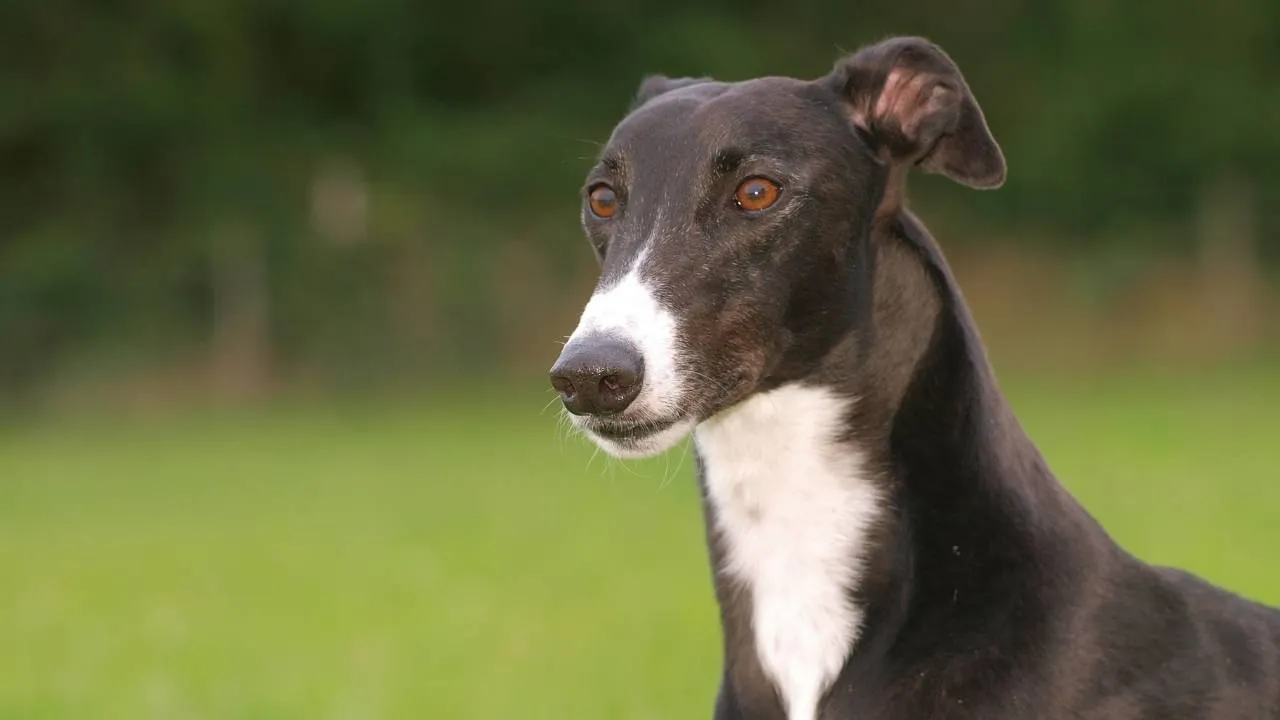
The Greyhound’s slim, tucked waist and long limbs help reduce air resistance during sprints. Deep chest cavities support rapid oxygen intake during explosive movements. Their feet have thick, firm pads that provide traction at high speeds.
Muscle Composition for Speed
With a high percentage of fast-twitch muscle fibers, Greyhounds generate powerful bursts of speed instantly. Their long, whip-like tails aid in balance when cornering. This natural structure allows them to reach up to 45 mph in just a few strides.
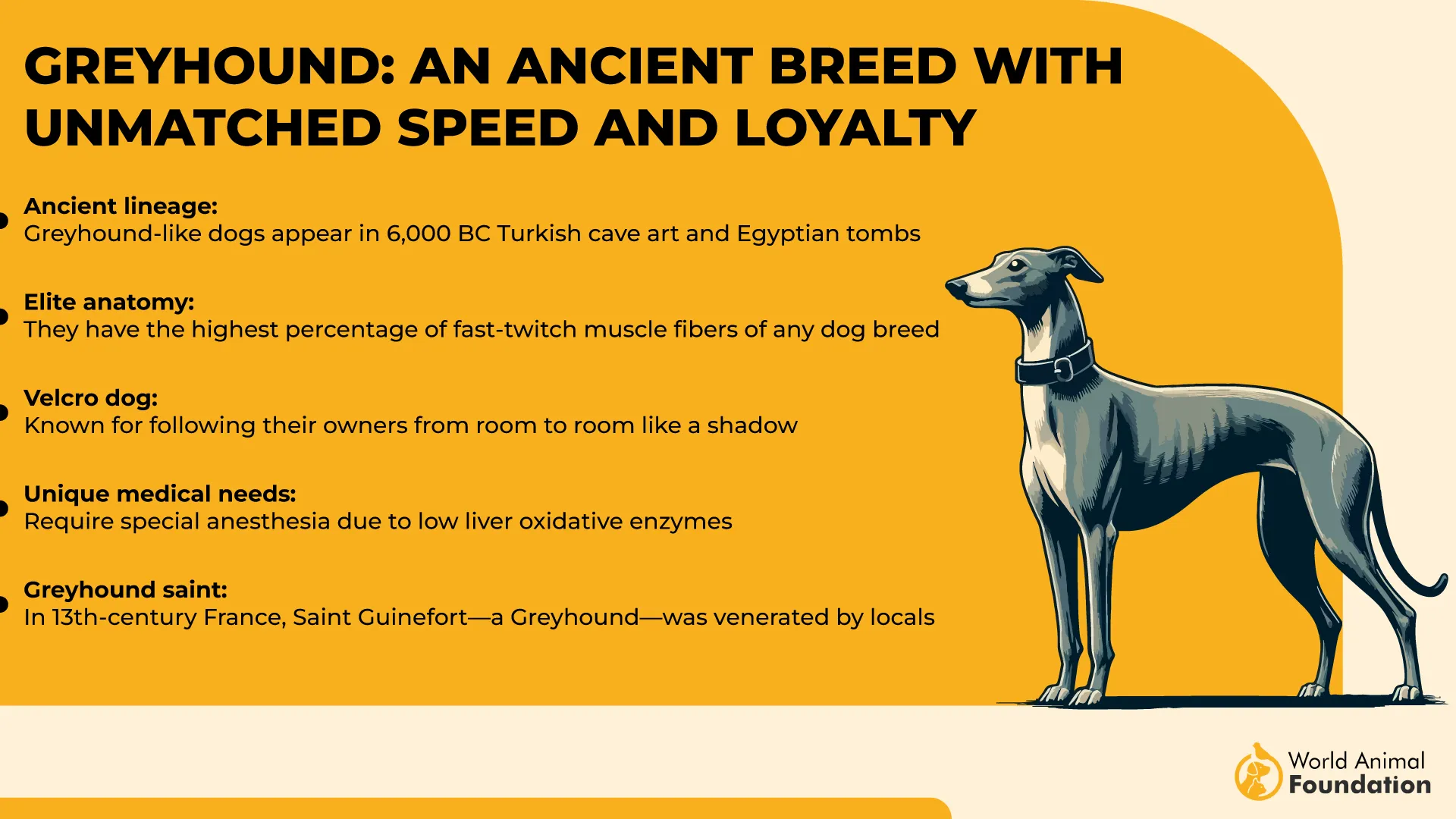
Efficient Sprint Mechanics
They use a double-suspension gallop, meaning all four feet leave the ground twice per stride. This movement pattern, also seen in cheetahs, gives them exceptional ground coverage. Their spine flexes like a spring, propelling them forward efficiently.
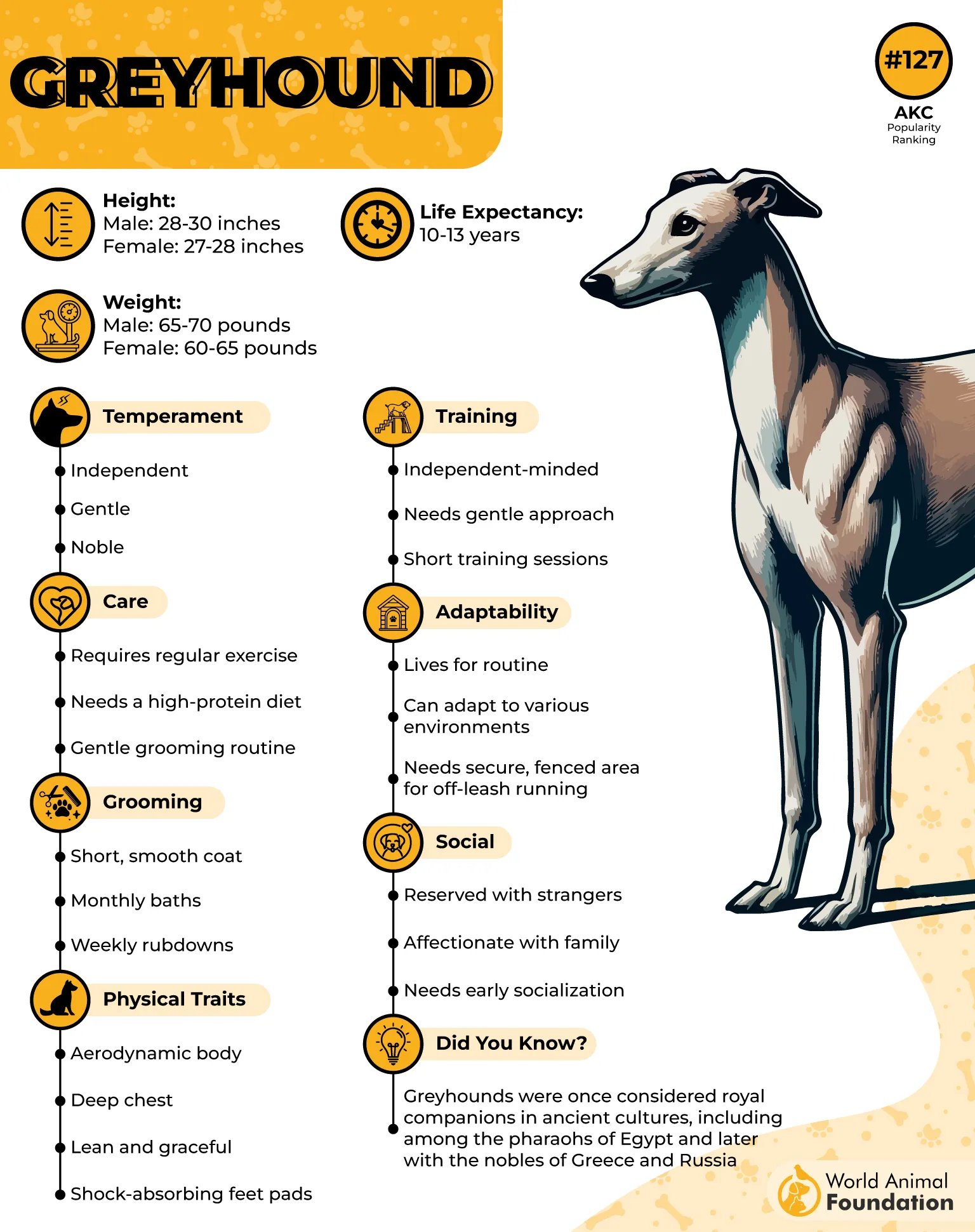
A Fun Fact Rooted in History
According to the Oxford Stadium, Greyhounds were originally bred for coursing game across open land, requiring speed and stamina. They remain one of the fastest dog breeds recognized worldwide, and they still dominate certain dog sports focused on sprint racing.
2. Saluki
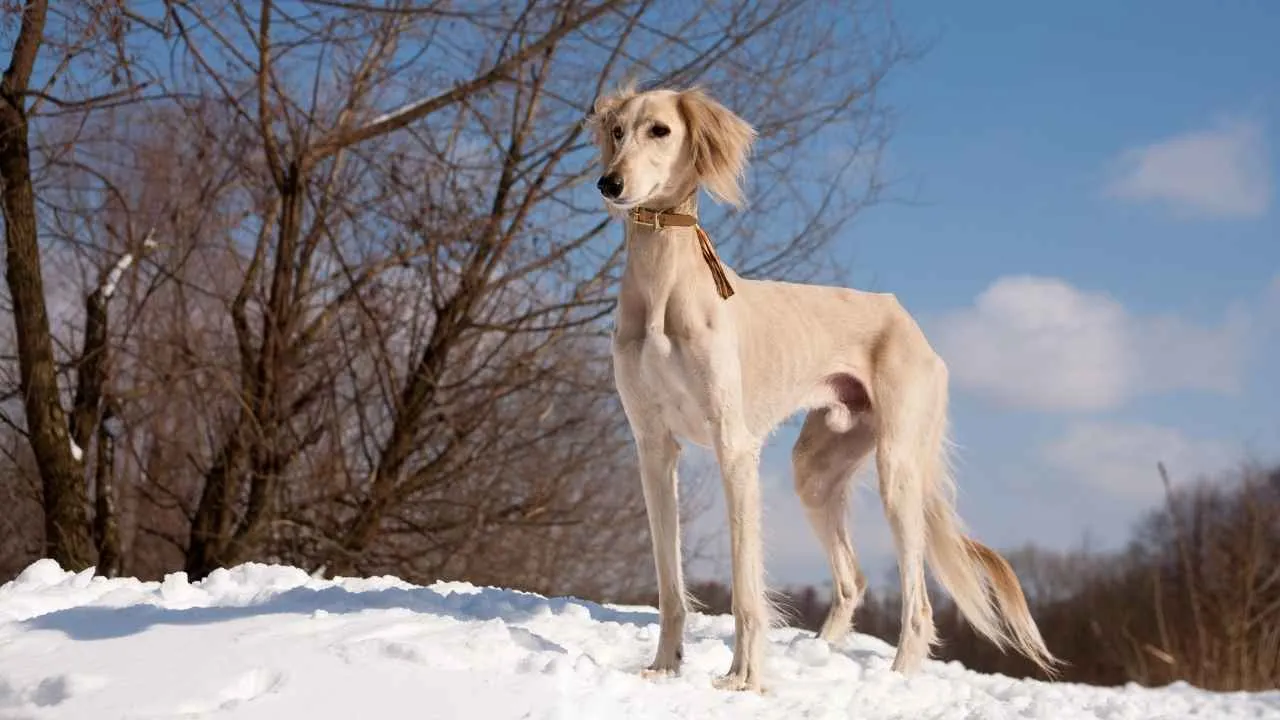
The Saluki’s fine-boned yet muscular build gives it an ideal balance of lightness and strength. Its narrow waist and flexible spine contribute to a smooth and energy-efficient stride. Long legs with padded feet support quick lift-off and controlled landings.
Built for Distance and Burst Speed
This breed combines endurance with surprising sprint capability, excelling in both open terrain and confined tracks. Their large lungs support strong oxygen flow during high-speed runs. Their gait stays incredibly steady, even during rapid turns.
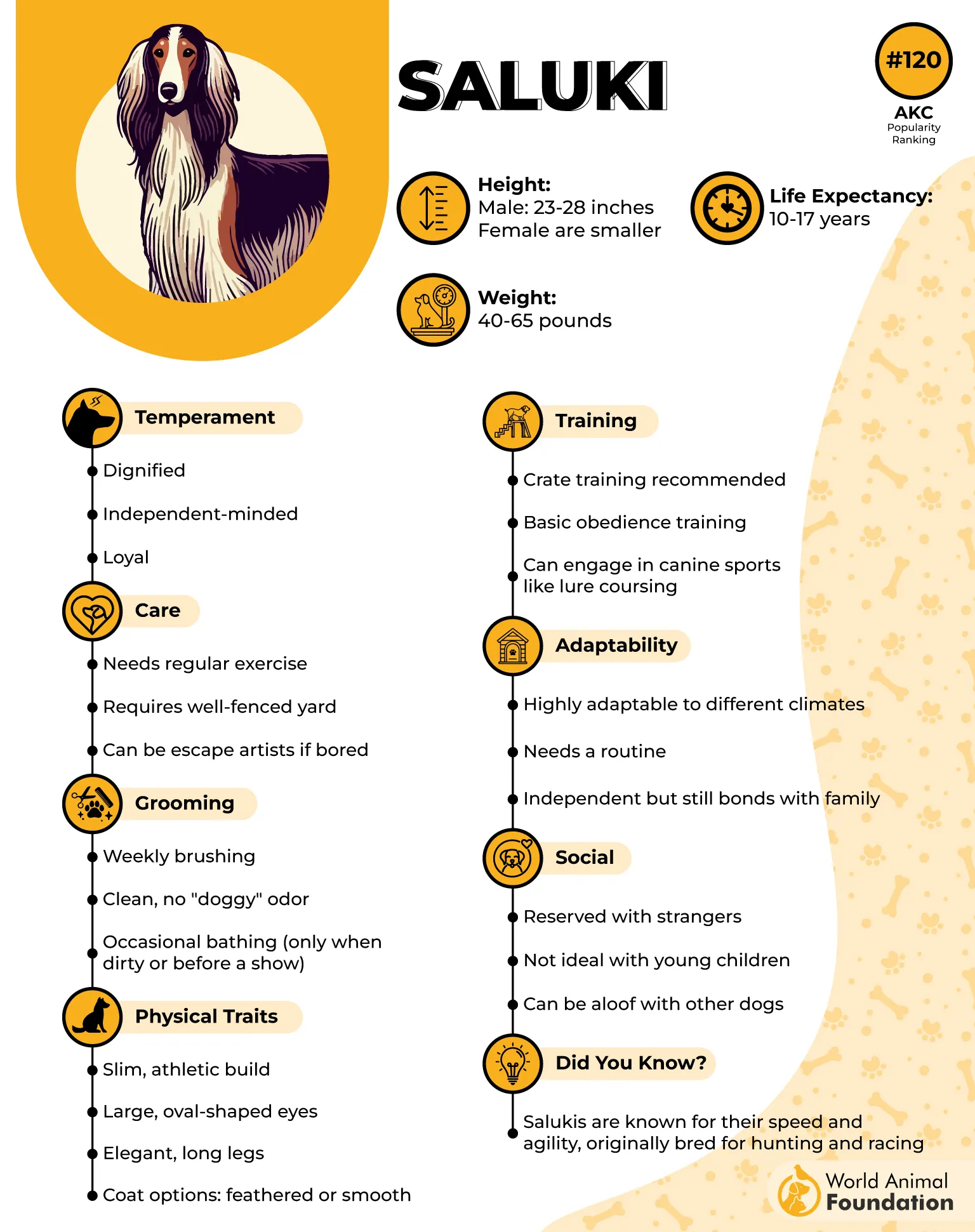
Naturally Calm with Agile Reflexes
Despite being a high-speed runner, the Saluki’s temperament is composed and responsive, which makes training easier. Their ability to assess surroundings mid-sprint helps avoid injury. These instincts are part of what makes them great family pets in active homes.
A Rare Feature Among Runners
The Saluki remains one of the few breeds still used in traditional dog racing across desert regions. As an athletic breed, their physical efficiency is admired by performance breeders. They’re among the oldest sighthounds still active in modern sprint events.
3. Sloughi
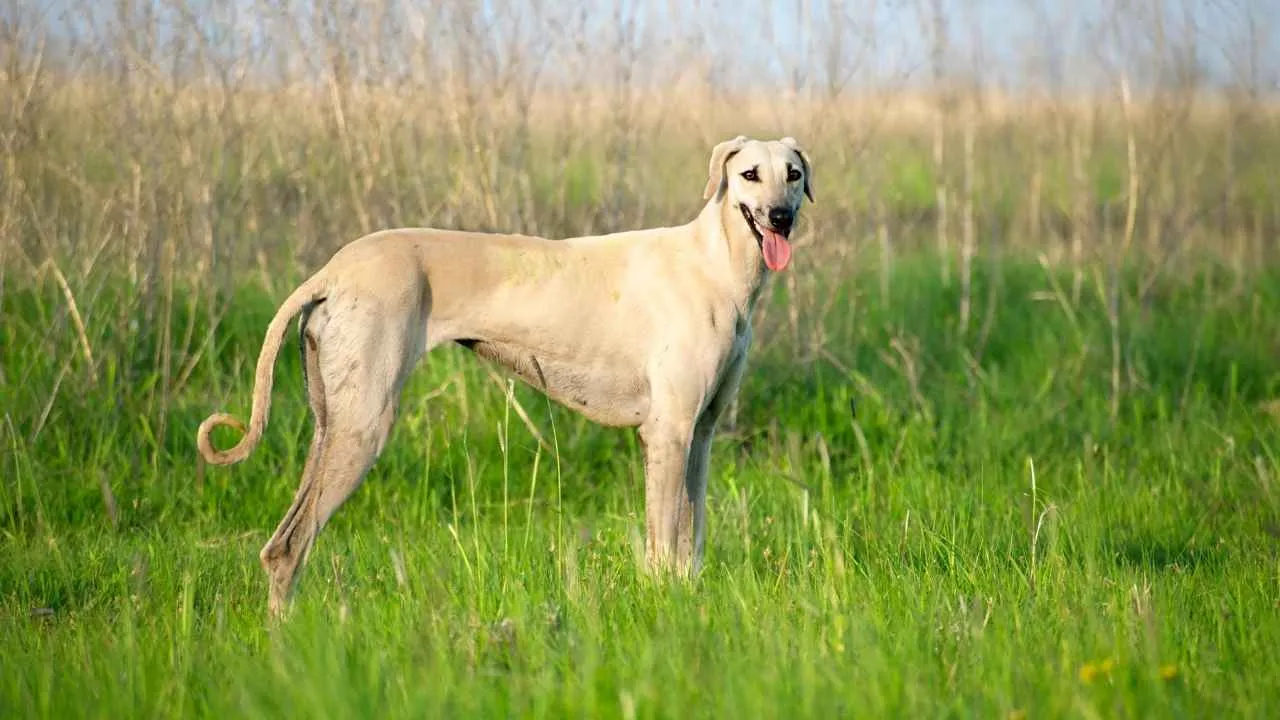
The Sloughi’s narrow head, lean body, and tucked abdomen allow it to cut through air with minimal drag. Its fine coat and low body fat reduce overheating during bursts of speed. Their long limbs are optimized for stride efficiency in flat terrain.
Light Frame, Heavy Precision
Unlike bulkier sprinters, the Sloughi maintains agility with a weight that rarely exceeds 65 pounds. They have a unique foot structure — elongated toes and firm pads — that enhances traction. This gives them a confident footing even at high speeds.
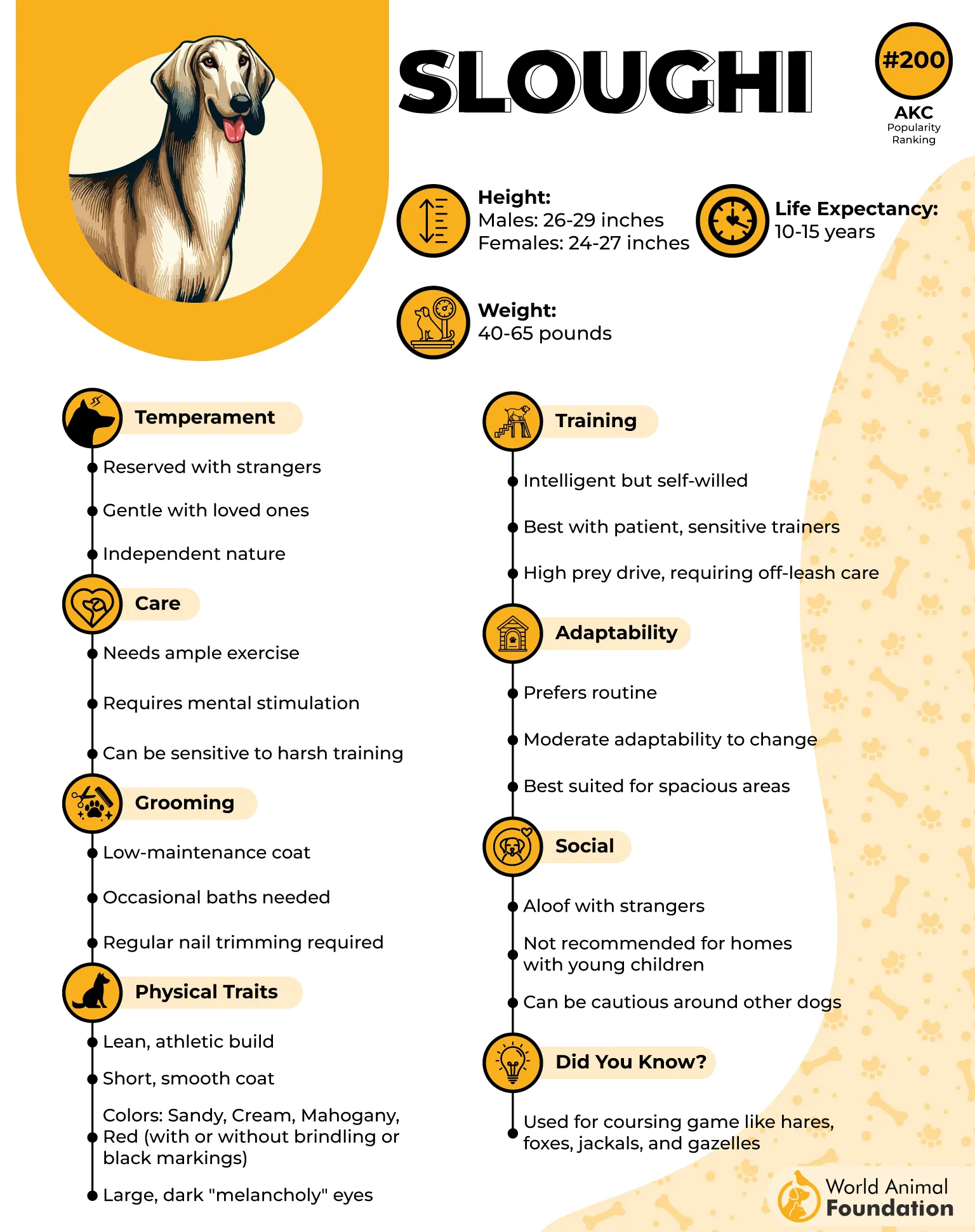
Built for Endurance and Focus
While known for sprinting, the breed can also cover long distances without losing pace. Their muscular hindquarters support extended movement, and their calm temperament keeps them focused on the run. That rare blend sets them apart from many other dogs.
Genetic Lineage of Consistency
Often compared to the Saluki for speed, the Sloughi holds its own in speed-based dog sports. They’re ideal for people with an active lifestyle who can match their need for movement. Few breeds balance sprinting power and endurance this naturally.
4. Afghan hound
The Afghan Hound’s long limbs and narrow frame contribute to its agility in open spaces. A naturally elevated hip structure helps generate long, extended strides. Their flowing coat doesn’t interfere with speed due to its lightweight, silky texture.
Sprint-Ready Bone Structure
This breed’s lean build hides a well-conditioned, muscular body beneath the coat. The springy gait comes from strong hindquarters and flexible joints. Their skeletal alignment allows for fast acceleration without compromising balance.
High Activity Threshold
Afghan Hounds have an inherently energetic disposition and perform best when given room to sprint. While independent in nature, they stay alert and responsive during active play. Most owners note their bursts of movement come in short, powerful intervals.
One of the Fastest Long-Haired Breeds
This breed is often listed among the top 10 in the world for natural sprinting speed. Its ability to combine endurance and elegance makes it a standout in agility circles. Despite the show-dog reputation, it remains built for speed at its core.
5. Vizsla
Vizslas have a lean and narrow build that supports effortless stride transitions while sprinting. Their lightweight frame reduces resistance, especially during sharp turns or long bursts. A clean silhouette gives them natural aerodynamic advantages in open spaces.
Energy Output and Movement Efficiency
They’re known for their ability to cover long distances with minimal fatigue, owing to efficient gait mechanics. Rear leg propulsion is strong, helping them launch into a sprint quickly. Their short coat minimizes heat buildup during intense movement.
High Drive and Reaction Speed
Vizslas react quickly to visual or scent-based triggers, making them excellent at high-speed starts. They’re highly responsive to motion, which makes them naturally inclined to chase moving objects. This breed pairs well with physically active owners and families with children.
Recognized for Their Need to Move
Their daily exercise requirement often exceeds an hour, especially in outdoor settings. They consistently rank among breeds that benefit most from structured running routines. A regular sprinting outlet is necessary for mental and physical balance.
6. Jack Russell terrier
The Jack Russell Terrier’s small, compact body hides an impressive amount of raw muscle. Their weight-to-power ratio allows them to launch forward with sudden speed. A strong neck and solid chest help them maintain control during sprints.
Quick Reflexes and Acceleration
This breed is known for rapid acceleration and quick ground contact during bursts. Their stride is short but incredibly efficient in tight or uneven spaces. That agility helps them change direction mid-run without losing momentum.
Energy That Converts to Speed
They are incredibly high-energy and have a low resting threshold, making them sprint-ready at nearly any moment. These dogs were designed to stay alert and responsive even after short rests. Regular exercise doesn’t just keep them healthy — it keeps their speed sharp.
Uncommon Vertical Ability
Jack Russells have been known to leap as high as five feet from a standstill — a rare feat for a breed of this size. That power comes from their strong hind legs and core muscles, contributing directly to their ground push-off strength when sprinting.
7. Dalmatian
Dalmatians have a clean, athletic build with long legs and a narrow waist that supports quick acceleration. Their relatively low body fat improves agility and contributes to a faster stride. This structure helps them maintain speed over extended ground.
Endurance-Driven Musculature
Their lean muscle mass allows for efficient energy use during high-speed runs. Dalmatians possess strong hindquarters that drive forward propulsion while keeping balance. The straight back and long stride enable smooth motion even on uneven surfaces.
Energy Levels That Match Performance
This breed has a naturally high energy threshold, allowing frequent bursts of activity without early fatigue. Dalmatians need regular movement and space, making sprint-friendly play a natural part of their daily rhythm. They also maintain focus well during physical exertion.
Known for Their Unique Stamina Role
Dalmatians were once selected to run beside horse-drawn carriages for hours without tiring — a job that required speed and long-distance pacing. Their ability to match equine gait for extended periods was tied directly to their structural endurance.
8. Whippet
Whippets have an ultra-light frame with a narrow chest and long legs built for short-distance speed. Their small size helps minimize drag, while their spine is incredibly flexible during galloping. The arch over the loin improves spring and rear-end propulsion.
Compact Yet Powerful Musculature
Though lean, Whippets carry concentrated muscle mass, especially in the thighs and shoulders. This balance gives them the ability to launch forward in rapid bursts. Their low body fat also contributes to faster heat dissipation during exertion.
Stride Efficiency in Motion
They use a double-suspension gallop, which keeps them airborne for much of their stride cycle. This motion allows Whippets to cover ground quickly with minimal energy loss. The arching and contracting of their body enhances stride length and frequency.
Unique Sprinting Trait
According to the Oxford Stadium, Whippets can reach speeds up to 35 mph, placing them just below Greyhounds in racing circles. They are one of the few breeds capable of matching professional track dogs in short bursts. Their nickname, “the poor man’s racehorse,” still holds among racing enthusiasts.
9. Borzoi
The Borzoi stands out with its narrow body and deep chest, ideal for covering long stretches of ground. Its long limbs and tucked abdomen contribute to efficient airflow and reduced drag. These features support agile movement across open spaces.
Stride and Flexibility
They possess a strong, flexible spine that helps generate stride extension during full-speed gallops. Their flowing movement is often described as floating, which helps reduce joint strain. This natural motion gives them an advantage in sustained running.
Muscle Distribution and Gait
Though not as bulky as some breeds, Borzoi have well-toned rear muscles that support strong push-off power. Their double-suspension gallop allows all four feet to leave the ground mid-stride. This unique gait plays a key role in their sprinting form.
Unique Combination of Speed and Silence
One trait consistently noted about Borzoi is their quiet, stealthy sprint — they move with little sound despite their size. This wasn’t developed for modern racing, but remains a consistent feature in their natural sprinting behavior.
10. Doberman Pinscher
The Doberman’s compact muscle structure and defined chest allow for quick bursts of speed. Their relatively light frame compared to other protection breeds supports agile sprints. A firm stance and long limbs make them naturally quick off the line.
Lean Musculature with Natural Agility
Unlike bulky dogs, Dobermans maintain lean muscles that adapt well to fast-paced movement. Their well-angulated hindquarters provide excellent drive from the rear. This balanced build supports short-distance acceleration and controlled cornering.
Responsive Reflexes and High Awareness
They are highly attuned to their environment and react instantly to movement, which enhances their performance during chase scenarios. Their ability to stay focused during motion-intensive activities keeps their pace consistent. Combined with mental alertness, this trait increases their efficiency in sprinting.
Rare Trait Among Large Breeds
Dobermans are one of the few large-sized breeds capable of reaching sprint speeds of up to 32 to 35 mph. Their balance of speed, control, and responsiveness makes them a unique entry in performance and working categories, often outperforming other large breeds in structured agility setups.
Conclusion
Not all dogs are built for distance—some are designed for extraordinary speed. From lean sighthounds to agile terriers, these breeds were made to chase, burst, and bolt.
Whether bred for racing, herding livestock, or tracking game, their structure reflects centuries of purpose-driven design. According to the American Kennel Club, breeds like the Greyhound and Whippet remain unmatched in sprint capability.
Even a medium-sized dog can combine power with agility. These animals thrive on motion, and while not all are easily trained, they excel when given the right outlet. If you live an active lifestyle or just want to see speed in action, these are the dogs who won’t just walk—they’ll fly.


